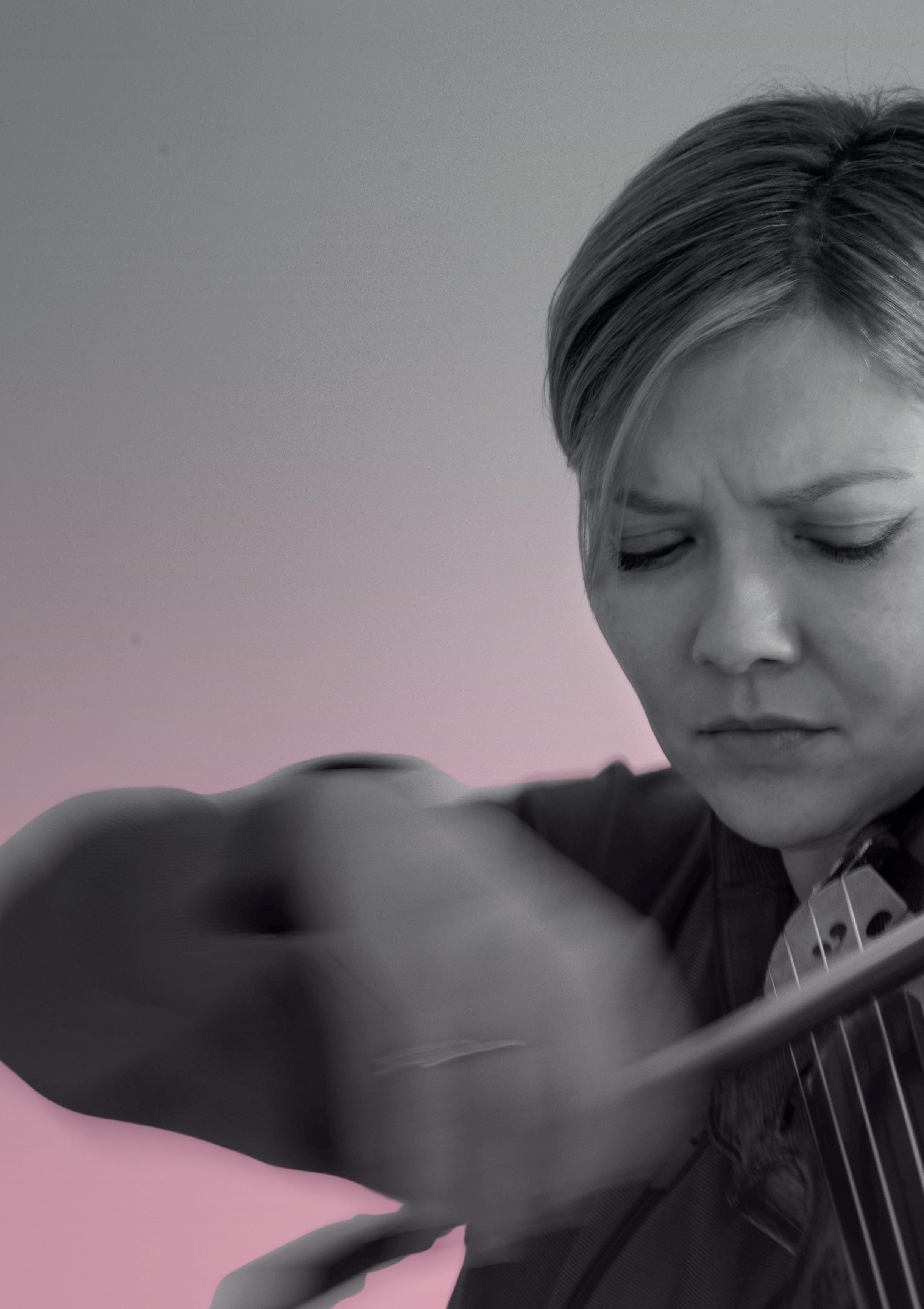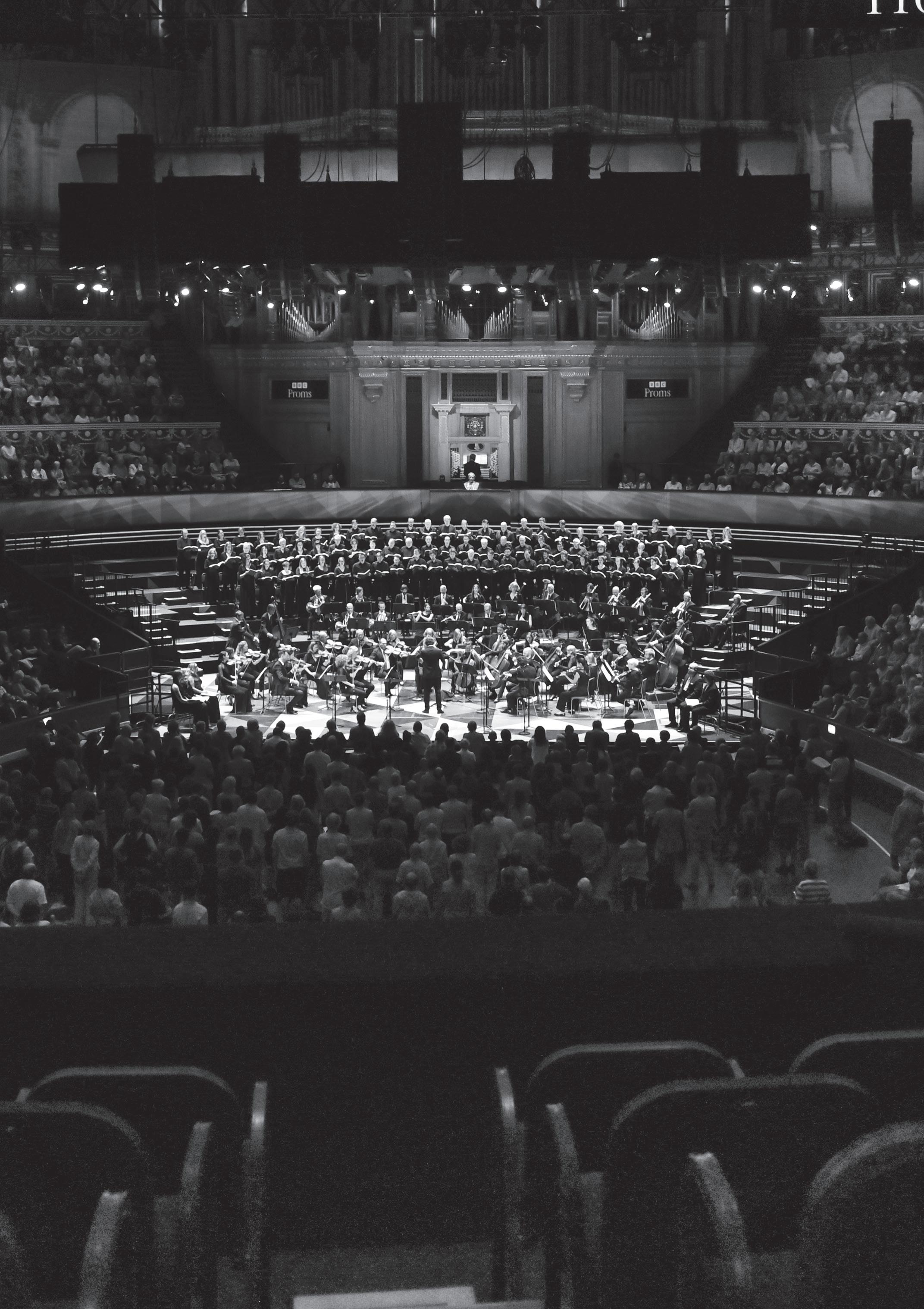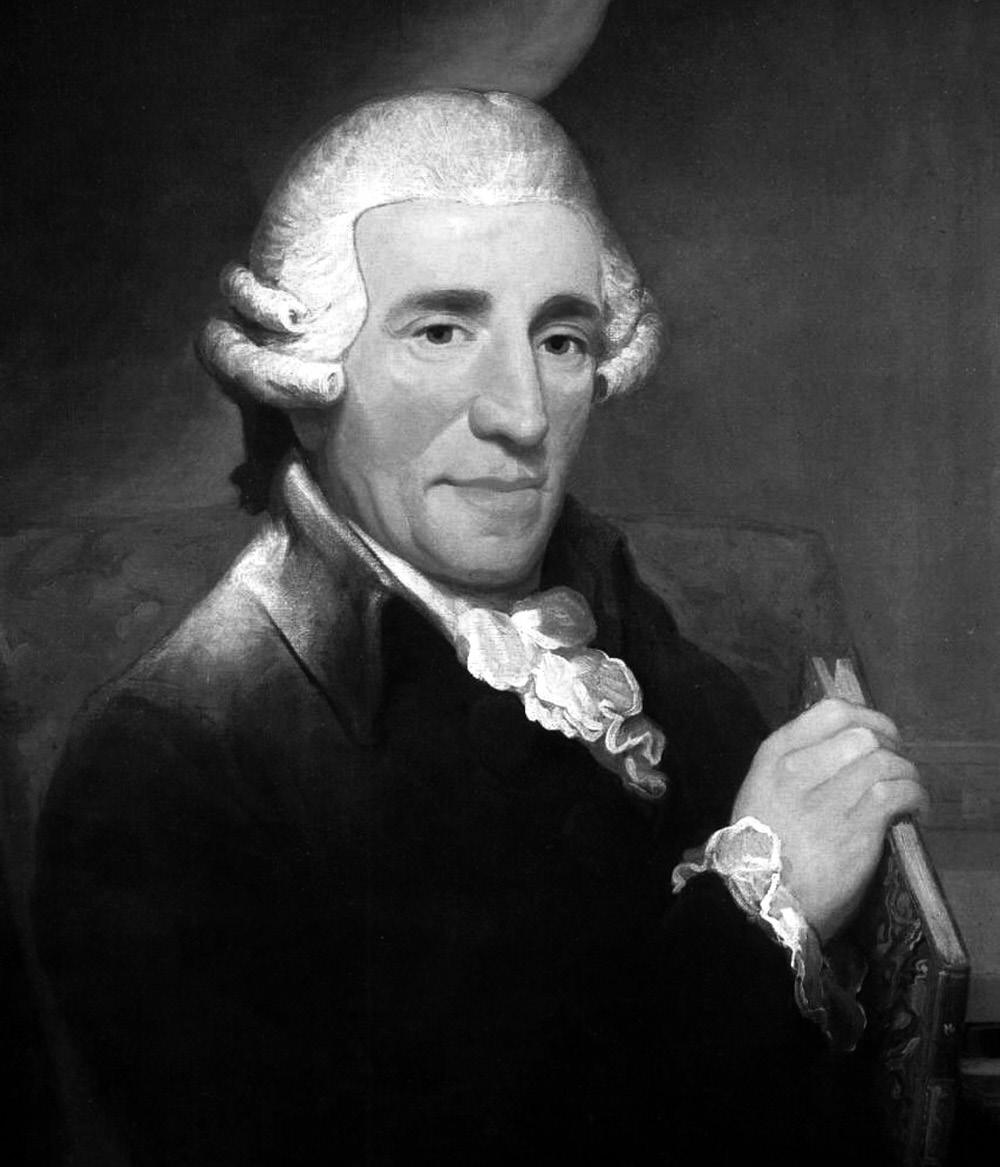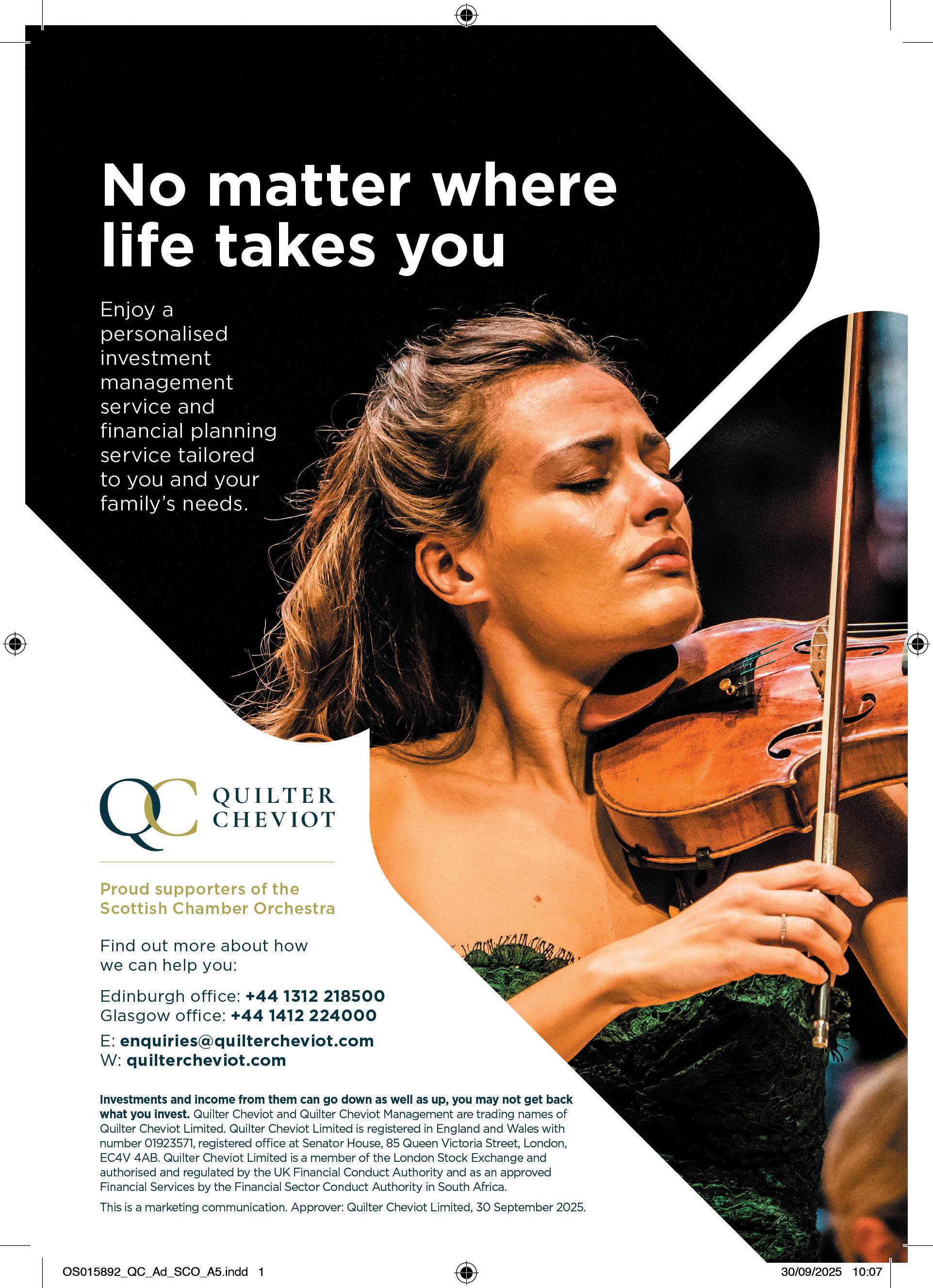
22-24 October 2025




22-24 October 2025


Wednesday 22 October, 7.30pm Holy Trinity Church, St Andrews
Thursday 23 October, 7.30pm The Queen's Hall, Edinburgh
Friday 24 October, 7.30pm City Halls, Glasgow
STRAUSS Suite in B-flat Op.4
HARTMANN Concerto funebre
Interval of 20 minutes
HAYDN Symphony No.103 in E-flat ‘Drum Roll’
Alina Ibragimova violin/director
Alina Ibragimova

4 Royal Terrace, Edinburgh EH7 5AB
+44 (0)131 557 6800 | info@sco.org.uk | sco.org.uk The Scottish Chamber Orchestra is a charity registered in Scotland No. SC015039. Company registration No. SC075079.
THANK YOU
Our Principal Conductor’s Circle are a special part of our musical family. Their commitment and generosity benefit us all – musicians, audiences and creative learning participants alike.
Annual Fund
James and Patricia Cook
Visiting Artists Fund
Harry and Carol Nimmo
Anne and Matthew Richards
International Touring Fund
Gavin and Kate Gemmell
Creative Learning Fund
Sabine and Brian Thomson
Conductor Emeritus Joseph Swensen
Donald and Louise MacDonald
Chorus Director Gregory Batsleer
Anne McFarlane
Principal Second Violin
Marcus Barcham Stevens
Jo and Alison Elliot
Second Violin Rachel Smith
J Douglas Home
Principal Viola Max Mandel
Ken Barker and Martha Vail Barker
Viola Brian Schiele
Christine Lessels
Viola Steve King
Sir Ewan and Lady Brown
Principal Cello Philip Higham
The Thomas Family
Sub-Principal Cello Su-a Lee
Ronald and Stella Bowie
Cello Donald Gillan
Professor Sue Lightman
American Development Fund
Erik Lars Hansen and Vanessa C L Chang
Productions Fund
Anne, Tom and Natalie Usher
Bill and Celia Carman
Scottish Touring Fund
Eriadne and George Mackintosh
Claire and Anthony Tait
Cello Eric de Wit
Jasmine Macquaker Charitable Fund
Principal Flute André Cebrián
Claire and Mark Urquhart
Principal Oboe
The Hedley Gordon Wright Charitable Trust
Sub-Principal Oboe Katherine Bryer
Ulrike and Mark Wilson
Principal Clarinet Maximiliano Martín
Stuart and Alison Paul
Principal Bassoon Cerys Ambrose-Evans
Claire and Anthony Tait
Sub-Principal Bassoon Alison Green
George Rubienski
Principal Horn Kenneth Henderson
Caroline Hahn and Richard Neville-Towle
Principal Timpani Louise Lewis Goodwin
Geoff and Mary Ball




Diamond
The Cockaigne Fund
Malcolm and Avril Gourlay
John and Jane Griffiths
James and Felicity Ivory
George Ritchie
Tom and Natalie Usher
Platinum
E.C. Benton
Michael and Simone Bird
Silvia and Andrew Brown
David Caldwell in memory of Ann
Dr Peter Williamson and Ms Margaret Duffy
Judith and David Halkerston
David and Elizabeth Hudson
Helen B Jackson
Dr and Mrs Peter Jackson
Dr Daniel Lamont
Graham and Elma Leisk
Professor and Mrs Ludlam
Chris and Gill Masters
Duncan and Una McGhie
Anne-Marie McQueen
James F Muirhead
Robin and Catherine Parbrook
Patrick and Susan Prenter
Mr and Mrs J Reid
Martin and Mairi Ritchie
Hilary E Ross
Elaine Ross
Sir Muir and Lady Russell
Jill and Brian Sandford
Michael and Elizabeth Sudlow
Robert and Elizabeth Turcan
Alan and Sue Warner
Anny and Bobby White
Robert Mackay and Philip Whitley
Finlay and Lynn Williamson
Ruth Woodburn
Gold
Peter Armit
Adam Gaines and Joanna Baker
John and Maggie Bolton
Elizabeth Brittin
Kate Calder
James Wastle and Glenn Craig
Jo and Christine Danbolt
James and Caroline Denison-Pender
Andrew and Kirsty Desson
David and Sheila Ferrier
Chris and Claire Fletcher
James Friend
Iain Gow
Margaret Green
Christopher and Kathleen Haddow
Catherine Johnstone
Julie and Julian Keanie
Gordon Kirk
Janey and Barrie Lambie
Mike and Karen Mair
Roy and Svend McEwan-Brown
John and Liz Murphy
Tom Pate
Maggie Peatfield
Sarah and Spiro Phanos
Charles Platt
Alison and Stephen Rawles
Andrew Robinson
Olivia Robinson
Anne McAlister and Philip Sawyer
Irene Smith
Dr Jonathan Smithers
Ian S Swanson
Ian and Janet Szymanski
John-Paul and Joanna Temperley
Douglas and Sandra Tweddl
Bill Welsh
Catherine Wilson
Neil and Philippa Woodcock
Silver
Roy Alexander
Fiona and Neil Ballantyne
The Batsleer Family
Jack Bogle
Jane Borland
Alan Borthwick
Dinah Bourne
Michael and Jane Boyle
Mary Brady
John Brownlie
Laura Buist
Robert Burns
Sheila Colvin
Lorn and Camilla Cowie
Adam and Lesley Cumming
Dr Wilma Dickson
Seona Reid and Cordelia Ditton
Sylvia Dow
Colin Duncan in memory of Norma Moore
Raymond Ellis
Dr and Mrs Alan Falconer
Sheila Ferguson
Dr William Irvine Fortescue
Dr David Grant
Anne Grindley
Andrew Hadden
J Martin Haldane
Ronnie and Ann Hanna
Roderick Hart
Norman Hazelton
Ron and Evelynne Hill
Philip Holman
Clephane Hume
Tim and Anna Ingold
David and Pamela Jenkins
Margaret Mortimer and Ken Jobling
Ross D. Johnstone
Professor Christopher and Mrs Alison Kelnar
Dr Ian Laing
Geoff Lewis
Dorothy A Lunt
Vincent Macaulay
James McClure in memory of Robert Duncan
Ben McCorkell
Lucy McCorkell
Gavin McCrone
Michael McGarvie
Brian Miller
Alistair Montgomerie
Andrew Murchison
Pamela Andrews and Alan Norton
Gilly Ogilvy-Wedderburn
John Peutherer in memory of Audrey Peutherer
James S Potter
Timothy Barnes and Janet Sidaway
Catherine Steel
John and Angela Swales
Takashi and Mikako Taji
C S Weir
Susannah Johnston and Jamie Weir
We are indebted to everyone acknowledged here who gives philanthropic gifts to the SCO of £300 or greater each year, as well as those who prefer to remain anonymous.
We are also incredibly thankful to the many individuals not listed who are kind enough to support the Orchestra financially on a regular or ad hoc basis. Every single donation makes a difference.
Become a regular donor, from as little as £5 a month, by contacting Hannah Wilkinson on 0131 478 8364 or hannah.wilkinson@sco.org.uk.
“…an orchestral sound that seemed to gleam from within.”

HM The King Patron
Donald MacDonald CBE
Life President
Joanna Baker CBE Chair
Gavin Reid LVO
Chief Executive
Maxim Emelyanychev
Principal Conductor
Andrew Manze
Principal Guest Conductor
Joseph Swensen
Conductor Emeritus
Gregory Batsleer
Chorus Director
Jay Capperauld
Associate Composer
Information correct at the time of going to print
First Violin
Alina Ibragimova
Afonso Fesch
Marie Schreer
Fiona Alexander
Aisling O’Dea
Amira Bedrush-McDonald
Sarah Bevan Baker
Catherine James
Second Violin
Marcus Barcham Stevens
Gordon Bragg
Rachel Smith
Wen Wang
Stewart Webster
Kristin Deeken
Viola
Max Mandel
Francesca Gilbert
Elaine Koene
Steve King
Cello
Philip Higham
Su-a Lee
Donald Gillan
Eric de Wit
Bass
Yehor Podkolzin
Jamie Kenny
Flute
André Cebrián
Marta Gómez
Oboe
Miriam Pastor
Katherine Bryer
Clarinet
Maximiliano Martín
William Stafford
Bassoon
Cerys Ambrose-Evans
Alison Green
Contrabassoon
Heather Brown
Philip Higham
Principal Cello
Horn
Kenneth Henderson
Jamie Shield
Gavin Edwards
Harry Johnstone
Trumpet
Peter Franks
Shaun Harrold
Timpani
Louise Lewis Goodwin

R STRAUSS (1864-1949)
Suite in B-flat major, Op.4 (1884)
Praeludium
Romanze
Gavotte
Introduction und Fuge
HARTMANN (1905-1963)
Concerto funebre (1939, revised 1959)
Introduktion: Largo
Adagio
Allegro di molto
Choral: Langsamer Marsch
HAYDN (1732-1809)
Symphony No.103 in E-flat ‘Drum Roll’ (1795)
Adagio - Allegro con spirito
Andante più tosto allegretto
Minuet - Trio
Finale: Allegro con spirito
Music exists to charm, delight and entertain, of course. But it also exists to challenge, defy, assert a point of view, give vent to fury or despair. We’ll encounter both of those intents among the high spirits and profound emotions of tonight’s concert, sometimes even mixed up within the same piece of music – from Richard Strauss’ joyful, career-launching Suite in B flat to Haydn’s intentionally crowd-pleasing Symphony No. 103, by way of Hartmann’s deeply moving cry of pain at Second World War atrocities in his Concerto funebre.
We begin, however, more than five decades before that conflict began. Richard Strauss turned 20 in 1884, and he was keen to establish himself as a professional musician. He’d been playing the piano from the age of four and composing since he was six, under the tutelage of some of his native Bavaria’s most accomplished musicians –including his own father Franz Strauss, who was one of the Germany’s most respected instrumentalists as Principal Horn at the Court Opera in Munich.
Three years earlier, the 17-year-old Richard’s single-movement Serenade in E-flat for 13 wind instruments had caught the attention of hugely influential conductor Hans von Bülow, who’d gone so far as programming the piece in a concert with his own Meiningen Court Orchestra, one of the starriest ensembles around at the time. The Serenade went down so well that von Bülow asked Strauss to create something along similar lines specially for the Orchestra, but on a grander scale, and across four movements. The young composer was delighted to oblige.
By the time Strauss set about working on what would become his Suite in B-flat,

The elder Strauss sought actively to steer his son away from the music of Wagner, but the young Richard would discover it anyway – and become deeply intoxicated by it.
he had several major pieces under his belt, including a Violin Concerto, two symphonies, and quite a lot of chamber music. He felt, however, a special affinity for wind music, possibly in part because of his father’s famed role: many of his earliest childhood compositions had been pieces for wind ensemble to be played at home.
Strauss’ father had exerted a profound influence, too, on the kind of music that he was writing. The elder Strauss held notoriously conservative attitudes, barely tolerating the dangerously modernistic creations that had been put together after the holy trinity of Haydn, Mozart and Beethoven (well, early Beethoven at least). Schubert, Mendelssohn, Schumann? Perhaps, just about. Wagner? Not a chance: Franz Strauss made no secret of his disdain for Wagner’s music, despite paradoxically playing much of it with
exceptional insight and brilliance in the Meiningen Orchestra.
In short, the elder Strauss sought actively to steer his son away from the music of Wagner, but the young Richard would discover it anyway – and become deeply intoxicated by it. Arguably, it’s that very tension between classical refinement and Wagnerian expressivity that would go on to shape Richard’s musical personality. In terms of his early Serenade and Suite, however, he was only too happy to follow his father’s guidance. Both are closely modelled on Mozart’s Serenade in B flat, K361 (the ‘Gran partita’), down to their ensemble of 13 wind instruments, even if Strauss updates Mozart’s earlier ensemble (comprising pairs of oboes, clarinets, basset horns and bassoons plus four horns and double bass) to the rather more modern grouping of pairs of flutes, oboes,
clarinets and bassoons, plus four horns and contrabassoon or tuba.
If the Suite launched Strauss’ career, however, it was a much as a conductor as it was as a composer. With the premiere set for 18 November 1884 in his home city of Munich, Strauss received notification as late as 22 October that year, via publisher Eugen Spitzweg, that von Bülow felt the young man should conduct the performance himself. The fact that he’d never wielded a baton in public before shouldn’t be an issue, von Bülow felt, since the Meiningen musicians would already be familiar with the music –which would also mean there’d be no need for a rehearsal. It was a huge challenge for the young man, and a huge gamble to accept that challenge. The premiere went so well, however, that von Bülow offered Strauss the position of Assistant Conductor in Meiningen six months later. Strauss would even step into von Bülow’s own shoes the following year, temporarily at least, following the elder musician’s surprise resignation.
A short tribute to Mozart had led to a longer commission, a prestigious conducting opportunity and then a longer-term job. And with the knowledge of the music that Strauss would produce in later decades, it’s not hard to see his early Suite in B-flat as a stepping stone between the more Mozart-indebted Serenade and his richer, more complex mature style. Its good-natured, confident Praeludium has a dense, rhythmically complex opening as the ensemble’s instruments elegantly dovetail their lines, though its outgoing beginning contrasts with its gentler, more plaintive later oboe theme. Strauss’ intricate, subtle scoring often pits several lines of music against each other at the same time, drawing on the distinctive
sonorities of the ensemble’s instruments, and subsides to a peaceful close.
Strauss puts the ensemble’s clarinets in the spotlight in the gentle Romanze, with a cadenza-like solo right at the start and a long-spun melody later on. The Gavotte feels more like a symphonic scherzo than the dance its title implies, its perky music based on a simple idea of three falling notes, heard several times at the very start. Strauss returns to a theme from the earlier Romanze to kick off his closing Introduction and Fugue, and draws in all manner of contrapuntal trickery in the main meat of the movement. After one of the ensemble’s horns (naturally) announces the fugue’s theme, it passes to clarinet, oboe and flute before later piling up on versions of itself, being stretched or compressing to doubleor half-speed, and even being flipped upside down. If Strauss is clearly out to demonstrate his compositional prowess, it’s nonetheless in music that propels the Suite to a joyful, delightful close.
By 1933, the nearly 70-year-old Strauss was one of Germany’s elder musical statesmen, a hugely respected and beloved figure with many of his iconic works – from Also sprach Zarathustra to Ein Heldenleben, Salome to Ariadne auf Naxos – already completed and welcomed warmly into the orchestral and operatic repertoires. It was also the year in which Adolf Hitler seized total control of the country, and the year in which tonight’s next composer, Karl Amadeus Hartmann, began work on his symphonic poem Miserae, an impassioned response to the opening of the Nazis’ first concentration camps, including the one in Dachau, near Munich.
Like Strauss, Hartmann had been born in Munich. He was a musical free spirit,

Hartmann began the Concerto in the summer of 1939, but the music took on a broader significance as the worldchanging events of that autumn unfolded.
alarming his teachers at the Munich Academy with his love for Stravinsky and Bartók, jazz and expressionism, and he retained his profound beliefs in democratic socialism throughout his life. It’s probably fairest to describe Strauss’ relationship with the Nazi regime as somewhat ambiguous: also in 1933, he perhaps ill-advisedly accepted the post of President of the Reich Music Chamber, effectively becoming the highest-ranking musical official in Nazi Germany, and also accepted commissions including an Olympic Hymn for the 1936 Berlin Games, while privately condemning and resisting the regime’s brutality and antisemitism.
Hartmann’s activities during Germany’s Nazi years were far clearer. He remained in the country, but he put himself into what’s been described as ‘inner migration’, withdrawing entirely from musical life, and refusing to
allow any of his music to be performed there. Nonetheless, his fame steadily grew outside Germany: his Miserae, for example, made a profound impact at its premiere in Prague in 1935. More importantly, however, during his years of ‘inner migration’ Hartmann continued to compose. Among his creations from that time was tonight’s Concerto funebre, written for solo violin and string orchestra.
The piece was originally inspired – or provoked, perhaps a better description – by the Nazi annexation of Czechoslovakia’s Sudetenland in 1938. Hartmann began the Concerto in the summer of 1939, but the music took on a broader significance as the world-changing events of that autumn unfolded. He later succinctly explained: ‘this particular time indicates the basic character and reason for my piece.’ It was premiered at St Gallen in neutral Switzerland on
29 February 1940 – remarkably, Hartmann was allowed out of tightly controlled Germany for the performance – under its original title Musik der Trauer (or ‘Music of Mourning’). When Hartmann came to make slight revisions to the piece in 1959, he changed its title to today’s Concerto funebre (literally ‘Funereal Concerto’).
It's the only solo concerto that Hartmann wrote, and it’s been suggested that he chose the violin explicitly for its similarities to the human voice, as if to provide a directness of expression for the feelings of fury, despair and hope that the Concerto so clearly conveys. Assigning specific emotions to music is always fraught, but here, Hartmann himself was clear. He later wrote about the Concerto to his close friend, conductor Hermann Scherchen: ‘I wanted to write down everything I thought and felt, and that resulted in form and melody. The intellectual and spiritual hopelessness of the period are contrasted with an expression of hope in the two chorales in the beginning and at the end.’
The Concerto’s four movements flow into one another (almost) without pauses. A loud, dissonant harmony settles onto a brooding unison at the very start of the brief Introduction, setting the Concerto’s seriousminded tone. When the soloist enters, slowly and quietly, it’s with fragments of the Bohemian Hussite hymn ‘You who are God’s Warriors’, perhaps a direct reference to the Nazi annexation of the Czech Sudetenland in 1938.
From quiet, brooding threat, the mood changes entirely in the second movement Adagio, with loud, frenetic tremolos from the orchestra, and a sudden ascent from the soloist to the very heights of their instrument.
The movement later calms, though the music remains angular and dissonant, and eventually moves into something like a slowmoving dance.
Hartmann’s third movement Allegro di molto is a grotesque scherzo that seems deliberately designed to unsettle with its brutal, driving rhythms, its screaming dissonances and its angular, angry solo violin line – though two interruptions from a mysterious, very quiet theme low in the violin’s range seem to come from another world entirely. It feels as if the movement has run out of energy – or perhaps resistance – in its slow, more mournful conclusion, followed by the Concerto’s only pause, written out precisely in Hartmann’s score.
His final movement is a funeral hymn, based on the popular Russian song ‘Immortal Victims’, commemorating those killed in the 1905 Revolution. That song’s broader significance to all those lost in conflict is clear, but at the same time, Hartmann had little time for the strictures of Soviet-style socialism despite his own progressive beliefs. Against hymn-like music from the orchestra, the soloist weaves a freer expression of grief, later joining the ensemble’s more communal mourning. If the Concerto appears to be closing in a mood of sorrow and resignation, however, then Hartmann’s very final gesture might imply otherwise – perhaps fury, determination and resistance.
The Concerto funebre was one of several wartime pieces that Hartmann revised in 1959. In others, he took pains to remove or tone down their more overt references to the darkness of the Nazi years, as if wanting to stress their more universal resonance, or to minimise the sense of his having

There’s no doubt that Haydn was out to charm and delight his London listeners, as the review acknowledges. But he was also out to prod them gently with some surprising innovations.
witnessed and warned against it. With the Concerto funebre, however, he left the musical substance largely untouched. He later explained what he hoped would be the piece’s legacy for future generations: ‘the threat to art will never be a thing of the past as long as freedom is threatened somewhere. That’s why we want to be vigilant, we want to warn, we want to remember past humiliation, we want to speak out when we recognise totalitarian tendencies anywhere.’
From wartime Germany, we leap back in time a century and a half for tonight’s final, far more joyful piece. By the time he wrote his ‘Drum Roll’ Symphony in 1794-5, Joseph Haydn had spent more than three decades employed in the lavish but rather isolated Eszterháza Palace, in what’s now north-west Hungary, then firmly at the heart of the Habsburg Empire. During those decades,
he’d used the wealthy Esterházy family’s resident musicians to the fullest, virtually inventing the modern symphony and string quartet as musical forms and developing his clean, clear, elegant and mischievously witty musical style across operas, chamber music and plenty more.
But equally, he felt he needed to stretch his wings. In 1790, aged 58, he found his chance. The incoming Prince Anton looked to trim his artistic outgoings, still guaranteeing an ongoing salary for Haydn, but no longer requiring his permanent presence. The composer’s music was already wildly popular among London audiences, and German-born, Londonbased impresario Johann Peter Salomon snapped him up for two visits to England, in 1791-2 and 1794-5. Both went down a storm, so much so that Haydn reportedly even considered settling permanently in the
English capital (and was explicitly invited to do so by King George III, no less).
He hobnobbed with royalty and the aristocracy, was fêted at high-society occasions and even received an honorary doctorate in Oxford (which provided his ‘Oxford’ Symphony, No.92, with its nickname). More importantly, with the six symphonies he composed for his first visit, he got to know just what his London listeners liked. When he returned two years later, he could give it to them all over again with six more ‘London’ symphonies – and plenty more besides. In that respect, Haydn’s second batch of ‘London’ symphonies – Nos 99 to 104 – represents a rare meeting of composer’s and audiences' minds: each knowing the other intimately and out to enjoy that relationship to the fullest.
In truth, Haydn had already prepared a lot of music for his second visit while back home in Vienna. But unusually, he wrote his Symphony No.103 – the penultimate of his 12 ‘London’ symphonies, and of his entire symphonic output – in London itself, during the winter of 1794-5. It was premiered on 2 March 1795 as part of a series of socalled Opera Concerts at the King’s Theatre, now the site of Her Majesty’s Theatre in Haymarket. Unsurprisingly, it went down a treat. The Morning Chronicle wrote: ‘Another new Overture [another name for Symphony], by the fertile and enchanting Haydn, was performed; which, as usual, had continual strokes of genius, both in air and harmony. The Introduction excited deepest attention, the Allegro charmed, the Andante was encored, the Minuets, especially the trio, were playful and sweet, and the last movement was equal, if not superior to the preceding.’
There’s no doubt that Haydn was out to charm and delight his London listeners, as the review acknowledges. But he was also out to prod them gently with some surprising innovations, not least the opening, call-to-attention drumroll which gives the Symphony its nickname. It serves as an appropriately seriousminded herald for the sombre, slow introduction that follows, which seems perpetually in search of its home key (and whose first four notes can’t help but bring to mind the ‘Dies irae’ plainchant, with all its associations of divine judgement and damnation). The change of mood when the movement’s blithe, scampering faster music arrives comes as quite a shock – although Haydn reprises some of his darker, slower music just before the movement’s end.
His slow movement alternates contrasting sections in the major and minor, growing in grandeur as it progresses, and is reputed to be based on Croatian folk songs that Haydn had studied. The composer also included a substantial violin solo, destined at the Symphony’s premiere for his London orchestra’s leader, Giovanni Battisti Viotti, himself an acclaimed soloist, conductor and composer.
Haydn’s elaborate minuet and trio take us a long way away from the ballroom, in rich, complex music that quickly moves into far richer harmonic regions than its opening suggests. A gentle, rising horn figure launches the spirited finale, which derives all of its material from a single theme, first heard in the violins (and bearing a striking resemblance to the all-pervasive figure that begins Beethoven’s Fifth).
© David Kettle

The 2025/26 season sees Alina Ibragimova perform with the Budapest Festival Orchestra, Orchestre symphonique de Montréal, London Philharmonic, Wiener Symphoniker, Finnish Radio Symphony, Atlanta Symphony, Tokyo Metropolitan Symphony, Dresdner Philharmonie, Boulez Ensemble and Kammerakademie Potsdam, working with conductors Iván Fischer, Robin Ticciati, Edward Gardner, Thomas Guggeis and Krzysztof Urbański. She also play-directs the Scottish Chamber Orchestra, Saint Paul Chamber Orchestra and Camerata Bern.
Highlights of the previous two seasons have included concerts with the Deutsches SymphonieOrchester Berlin, Netherlands Radio Philharmonic, Camerata Salzburg, Mahler Chamber Orchestra, Royal Stockholm Philharmonic, Deutsche Kammerphilharmonie Bremen, Detroit Symphony, Rundfunk-Sinfonieorchester Berlin, Bamberger Symphoniker, WDR Sinfonieorchester and City of Birmingham Symphony, with conductors Vladimir Jurowski, Hannu Lintu, Ryan Bancroft, Maxim Emelyanychev and Anja Bihlmaier.
In recital, Alina regularly performs with pianist Cédric Tiberghien and together they continue their cycle of Beethoven’s sonatas for violin and piano on period instruments at Wigmore Hall. Other chamber projects this season include recitals at Berlin’s Boulez Saal and Amsterdam’s Concertgebouw and Muziekgebouw, as well as performances with the Chiaroscuro Quartet of which Alina is a founding member.
For full biography please visit sco.org.uk

The Scottish Chamber Orchestra (SCO) is one of Scotland’s five National Performing Companies and has been a galvanizing force in Scotland’s music scene since its inception in 1974. The SCO believes that access to world-class music is not a luxury but something that everyone should have the opportunity to participate in, helping individuals and communities everywhere to thrive. Funded by the Scottish Government, City of Edinburgh Council and a community of philanthropic supporters, the SCO has an international reputation for exceptional, idiomatic performances: from mainstream classical music to newly commissioned works, each year its wide-ranging programme of work is presented across the length and breadth of Scotland, overseas and increasingly online.
Equally at home on and off the concert stage, each one of the SCO’s highly talented and creative musicians and staff is passionate about transforming and enhancing lives through the power of music. The SCO’s Creative Learning programme engages people of all ages and backgrounds with a diverse range of projects, concerts, participatory workshops and resources. The SCO’s current five-year Residency in Edinburgh’s Craigmillar builds on the area’s extraordinary history of Community Arts, connecting the local community with a national cultural resource.
An exciting new chapter for the SCO began in September 2019 with the arrival of dynamic young conductor Maxim Emelyanychev as the Orchestra’s Principal Conductor. His tenure has recently been extended until 2028. The SCO and Emelyanychev released their first album together (Linn Records) in 2019 to widespread critical acclaim. Their second recording together, of Mendelssohn symphonies, was released in 2023, with Schubert Symphonies Nos 5 and 8 following in 2024.
The SCO also has long-standing associations with many eminent guest conductors and directors including Principal Guest Conductor Andrew Manze, Pekka Kuusisto, François Leleux, Nicola Benedetti, Isabelle van Keulen, Anthony Marwood, Richard Egarr, Mark Wigglesworth, Lorenza Borrani and Conductor Emeritus Joseph Swensen.
The Orchestra’s current Associate Composer is Jay Capperauld. The SCO enjoys close relationships with numerous leading composers and has commissioned around 200 new works, including pieces by Sir James MacMillan, Anna Clyne, Sally Beamish, Martin Suckling, Einojuhani Rautavaara, Karin Rehnqvist, Mark-Anthony Turnage, Nico Muhly and the late Peter Maxwell Davies.



Each year, the SCO must fundraise around £1.2 million to bring extraordinary musical performances to the stage and support groundbreaking education and community initiatives beyond it.
If you share our passion for transforming lives through the power of music and want to be part of our ongoing success, we invite you to join our community of regular donors. Your support, no matter the size, has a profound impact on our work – and as a donor, you’ll enjoy an even closer connection to the Orchestra.
To learn more and support the SCO from as little as £5 per month, please contact Hannah at hannah.wilkinson@sco.org.uk or call 0131 478 8364.
SCO is a charity registered in Scotland No SC015039.